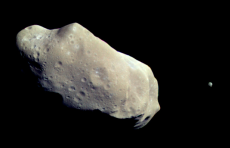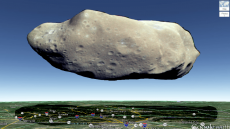
Asteroid Ida is part of the asteroid belt, a huge ring of rocks that orbit between Mars and Jupiter. It is part of the Koronis family, a cluster of asteroids that were made two billion years ago when two large planets collided. Ida has been hit by so many other asteroids that it has one of the most cratered surfaces in the Solar System. In fact, it has so many that it’s almost impossible for the number to go up, as any new craters would just cover up old ones.
Ida is 58.9km long, which makes it longer than the distance between Liverpool and Manchester! The image below shows an artist’s impression of Ida compared to St Louis, Missouri. Ida’s moon, Dactyl, was the first asteroid moon that scientists discovered. It is only 1.4km long, one-twentieth the size of Ida, about the length of twelve football pitches.
The asteroid was first discovered in 1884 by Johann Palisa at Vienna Observatory in Austria. It was the 45th asteroid he’d discovered, and he would go on to discover 122 in total. Palisa let his friend Moritz von Kuffner name the asteroid, because he’d paid for a huge observatory to be built in Vienna. Kuffner named it after Mount Ida in Crete, which is where Greek mythology says Zeus was born.

In 1993 a spacecraft called Galileo visited Ida on its way to Jupiter. This was only the second time a spacecraft had been sent to view an asteroid. Galileo sent pictures back to NASA as it flew past Ida, which meant that we could see the asteroid from many different angles. These showed scientists that Ida is actually made up of two huge rocks with a ‘waist’ of debris or smaller rocks holding it together in the middle.
The fly-by also lead to the discovery of Ida’s moon Dactyl, after NASA member Ann Harch spotted it in Galileo’s images. It was named after a mythical race who lived on Mount Ida and were believed to be healing magicians and metalworkers. Galileo used a special detector called a spectroscope to find out what Ida is made of, and confirmed that it is an S-type asteroid. This means it is made of silicate rock, or rock made of compounds containing the element Silicon. S-types are common in the inner part of the asteroid belt, but they only make up 17% of all the asteroids we know about.
Galileo also helped scientists to work out Ida’s gravitational field, or how strong the forces are which pull objects towards it. Its field is so weak that an astronaut could easily leap from one end of Ida to the other! Scientists also got to map Ida’s main features, including a crater called Lascaux which is 12km wide, nearly a fifth of the whole length of the asteroid. All of Ida’s craters are named after cave’s and lava tubes on Earth; Lascaux is a cave in France with some of the most well-preserved and famous prehistoric paintings.
Images: Wikipedia commons; Ciro Villa via universetoday.com.

0 Comment:
Be the first one to comment on this article.